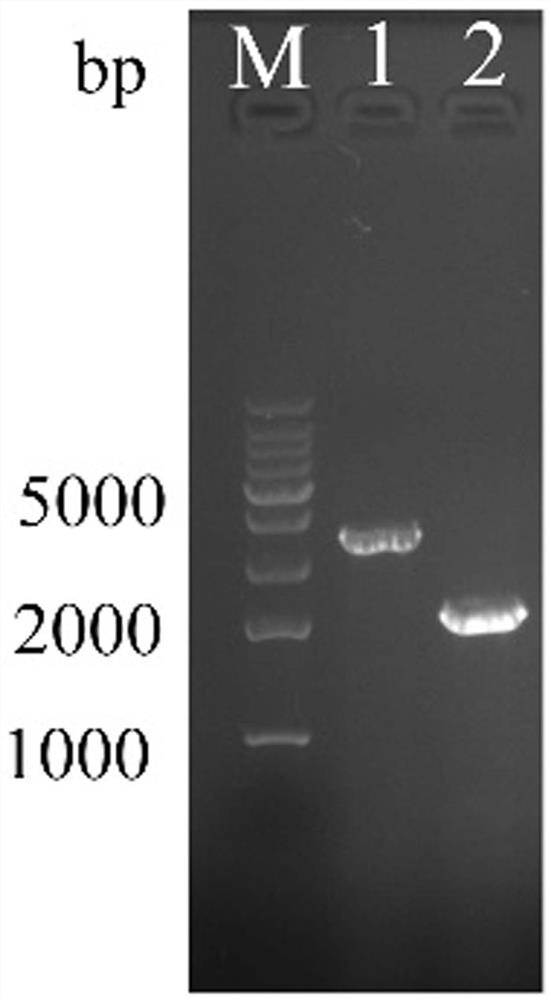A genetically engineered bacterium and its application in the preparation of 22-hydroxyl-23,24-bisnorcholest-4-en-3-one
A technology of genetically engineered bacteria and hydroxyl, applied in the field of genetic engineering, can solve problems such as being unsuitable for large-scale industrial production, and achieve the effects of easy separation and purification, reducing pollution and reducing production costs
- Summary
- Abstract
- Description
- Claims
- Application Information
AI Technical Summary
Problems solved by technology
Method used
Image
Examples
Embodiment 1
[0025] Embodiment 1: Construction of gene knockout plasmid
[0026] 3-sterone-∆ 1 -Dehydrogenase encoding gene ( kstd ) as shown in SEQ ID NO: 1, 17-hydroxy-3-oxo-4-pregnene-20-carboxy-CoA aldolase encoding gene ( ltp2 ) such as SEQ ID NO: 2, according to the following methods to construct the knockout kstd and knockout ltp2 of plasmids.
[0027] Starting strain Mycobacterium neoaurum (Strain No.: Mycobacterium neoaurum NRRLB-3805) genome was used as template for PCR amplification.
[0028] PCR system:
[0029] 5×Phusion GC Buffer 10 μl
[0030] 2mM dNTPs 5 μl
[0031] Primer F 1 μl
[0032] Primer R 1 μl
[0033] Template DNA 50-100ng
[0034] DMSO 1.5 μl
[0035] Phusion 0.5 μl
[0036] wxya 2 O to 50 μl
[0037] PCR program: 3 min at 98°C; denaturation at 98°C for 10 s, annealing at 58°C for 20 s, extension at 72°C for 30 s, 30 cycles; 10 min at 72°C. The primer sequences used are:
[0038] for kstd :
[0039] Upstream fragment primers:
[0040] ...
Embodiment 2
[0060] Example 2: Screening of knockout strains
[0061] Electrotransform the constructed gene knockout plasmid into the starting strain Mycobacterium neoaurum (Strain No.: Mycobacterium neoaurum NRRL B-3805) Competent cells, coated with Kan-resistant LB plates (tryptone: 10g / L, yeast extract: 5g / L, sodium chloride: 10g / L, Kan: 50μg / ml, agar: 1.5% ) and add IPTG and X-gal for the first screening. Pick blue single colonies to sucrose plate (tryptone: 10g / L, yeast extract: 5g / L, sucrose: 10g / L, agar: 1.5%) (add IPTG and X-gal) from it, carry out the second time filter. Pick the white colony on the sucrose plate to the liquid LB medium, culture at 30°C for about 36 hours, extract the genome, and use the Up-F and Down-R primers of the target gene for PCR verification. If the gene knockout is successful, the PCR product should be a single fragment of about 1900 bp. figure 2 shows that the successful kstd Knockout mycobacterial strains. right kstd The knockout strains w...
Embodiment 3
[0062] Embodiment 3: Construction of gene expression bacterial strain
[0063] 3.1 Expression plasmid construction
[0064] Primers cxgAB-F and cxgAB-R were used to amplify from Mycobacterium Acetyl-CoA acetyltransferase / thiolase gene (cxgA) and DNA-binding protein gene (cxgB) in the sp. NRRL B-3805 genome, after obtaining the cxgAB fragment with a 15bp homology arm with the plasmid pMV261, and expressing Plasmid pMV261 was digested and purified by EcoRI and HindIII to obtain a single-fragment connection, and the recombinant expression plasmid 261-cxgAB was obtained.
[0065] PCR system:
[0066] 5×Phusion GC Buffer 10 μl
[0067] 2mM dNTPs 5 μl
[0068] Primer F 1 μl
[0069] Primer R 1 μl
[0070] Template DNA 50-100ng
[0071] DMSO 1.5 μl
[0072] Phusion 0.5 μl
[0073] wxya 2O to 50 μl
[0074] PCR program: 3 min at 98°C; denaturation at 98°C for 10 s, annealing at 58°C for 20 s, extension at 72°C for 30 s, 30 cycles; 10 min at 72°C. The primer sequences use...
PUM
 Login to View More
Login to View More Abstract
Description
Claims
Application Information
 Login to View More
Login to View More - Generate Ideas
- Intellectual Property
- Life Sciences
- Materials
- Tech Scout
- Unparalleled Data Quality
- Higher Quality Content
- 60% Fewer Hallucinations
Browse by: Latest US Patents, China's latest patents, Technical Efficacy Thesaurus, Application Domain, Technology Topic, Popular Technical Reports.
© 2025 PatSnap. All rights reserved.Legal|Privacy policy|Modern Slavery Act Transparency Statement|Sitemap|About US| Contact US: help@patsnap.com



